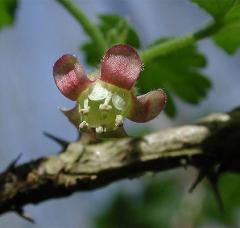Ribes uva-crispa
Taxonomy: Angiospermae, Saxifragales, Grossulariaceae, Ribes
Links: http://flora.nhm-wien.ac.at/Seiten-Arten/Ribes-uva-crispa-uva.htm
Published: 2020-11-24
Pollen Description
Shape, Size and Aperture
pollen unit: monad, dispersal unit and peculiarities: monad, size (pollen unit): medium-sized (26-50 µm), size of hydrated pollen (LM): 21-25 µm, shortest polar axis in equatorial view (LM): -, longest polar axis in equatorial view (LM): -, shortest diameter in equatorial or polar view (LM): 21-25 µm, longest diameter in equatorial or polar view (LM): 21-25 µm, pollen class: porate, polarity: -, P/E-ratio: -, shape: spheroidal, outline in polar view: circular, dominant orientation (LM): oblique, P/E-ratio (dry pollen): -, shape (dry pollen): irregular, outline in polar view (dry pollen): irregular, infoldings (dry pollen): irregularly infolded, aperture number: >6, aperture type: porus, aperture condition: porate, pantoporate, aperture peculiarities: pantoaperturate, annulus
Ornamentation and Structure
LM ornamentation LM: psilate, nexine: -, sexine: -, SEM ornamentation SEM: psilate, perforate, suprasculpture SEM: -, TEM tectum: -, infratectum: -, foot layer: -, endexine: -, intine: -, wall peculiarities: -, supratectal element: -
Miscellaneous
pollen coatings: -, reserves in cytoplasm: -, cell number: -, Ubisch bodies: -
Annotations: pores situated in elongated, colpus-like areas; possible interpretation: colporate
Author(s) of diagnosis: Halbritter, Heidemarie; Heigl, Helmut
Pictures
Picture legend
- flower(s), photographer: Schneider, H.
- flower(s), photographer: Halbritter, H.
- hydrated pollen - fresh, glycerine, unstained, photographer: Heigl, H.
- hydrated pollen - fresh, glycerine, ruthenium red, photographer: Heigl, H.
- hydrated pollen - fresh, glycerine, ruthenium red, photographer: Heigl, H.
- hydrated pollen grains - fresh, rehydrated (water) & critical point dried & sputter coated with gold, photographer: Halbritter, H.
- hydrated pollen grain - fresh, rehydrated (water) & critical point dried & sputter coated with gold, photographer: Halbritter, H.
- hydrated pollen grain - fresh, rehydrated (water) & critical point dried & sputter coated with gold, photographer: Halbritter, H.
- apertural area - fresh, rehydrated (water) & critical point dried & sputter coated with gold, photographer: Halbritter, H.
- dry pollen grains - dry, sputter coated with gold, photographer: Halbritter, H.
Literature
- (1998) Preparing living pollen material for scanning electron microscopy using 2,2-dimethoxypropane (DMP) and criticalpoint drying. Biotechnic Histochem 73: 137–143
Copyright and Citation
Cite this publication as:
Halbritter H., Heigl H., Schneider H. 2020. Ribes uva-crispa. In: PalDat - A palynological database. https://www.paldat.org/pub/Ribes_uva-crispa/304002; accessed 2024-11-01










